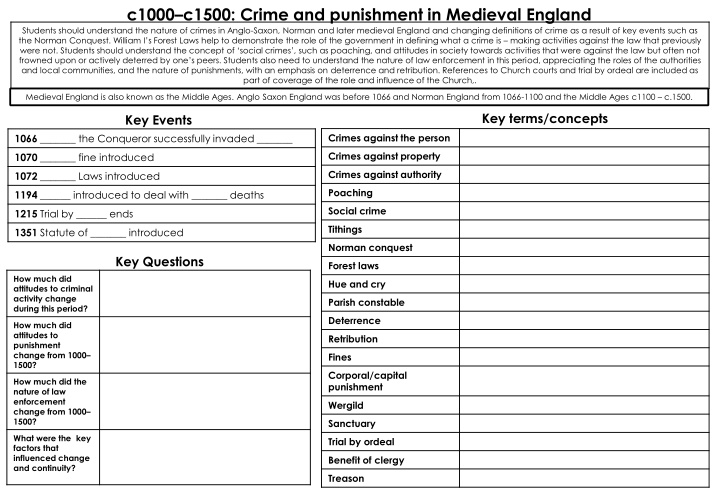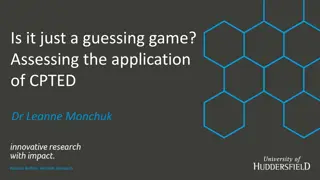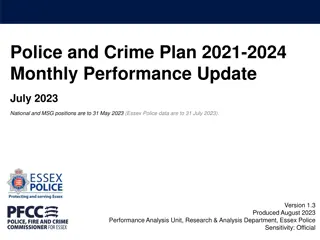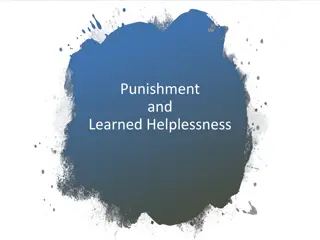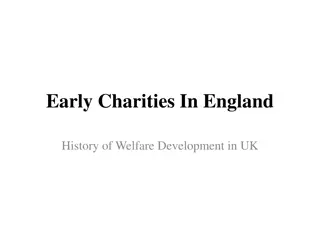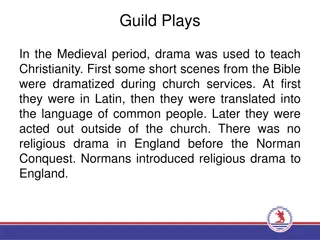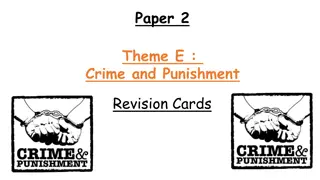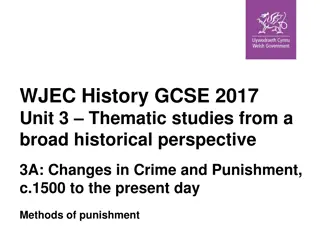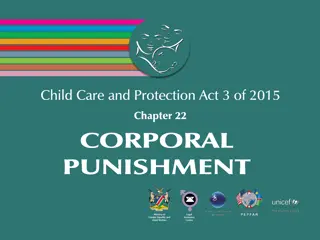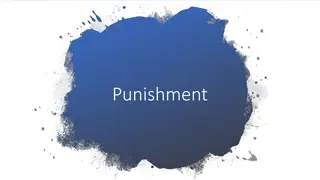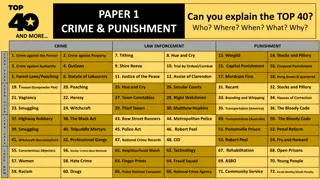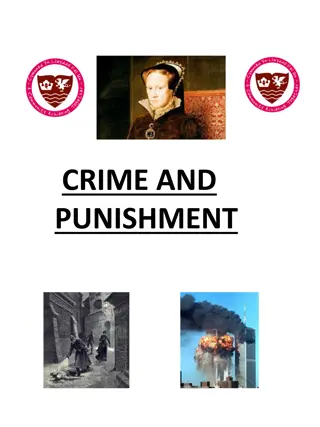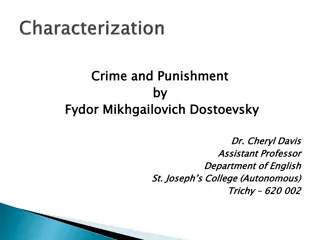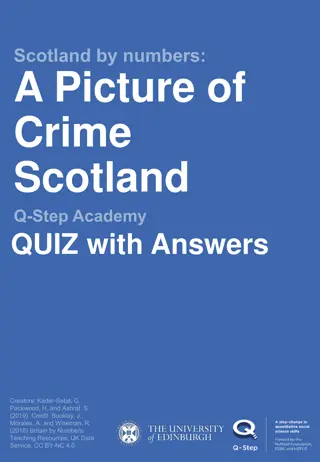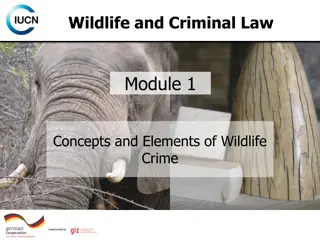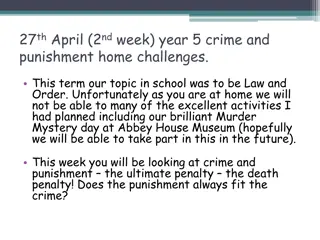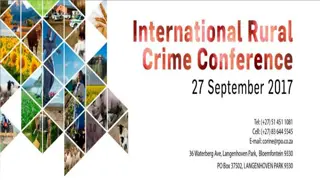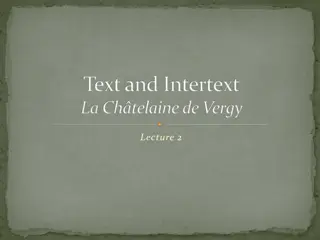Evolution of Crime and Punishment in Medieval and Early Modern England
Explore the evolution of crime and punishment in Medieval and Early Modern England, tracing changes in definitions of crime, law enforcement methods, and societal attitudes. From Norman Forest Laws to the Gunpowder Plot and witch-hunts, discover key events and concepts shaping criminal justice over centuries.
Download Presentation

Please find below an Image/Link to download the presentation.
The content on the website is provided AS IS for your information and personal use only. It may not be sold, licensed, or shared on other websites without obtaining consent from the author.If you encounter any issues during the download, it is possible that the publisher has removed the file from their server.
You are allowed to download the files provided on this website for personal or commercial use, subject to the condition that they are used lawfully. All files are the property of their respective owners.
The content on the website is provided AS IS for your information and personal use only. It may not be sold, licensed, or shared on other websites without obtaining consent from the author.
E N D
Presentation Transcript
c1000c1500: Crime and punishment in Medieval England Students should understand the nature of crimes in Anglo-Saxon, Norman and later medieval England and changing definitions of crime as a result of key events such as the Norman Conquest. William I s Forest Laws help to demonstrate the role of the government in defining what a crime is making activities against the law that previously were not. Students should understand the concept of social crimes , such as poaching, and attitudes in society towards activities that were against the law but often not frowned upon or actively deterred by one s peers. Students also need to understand the nature of law enforcement in this period, appreciating the roles of the authorities and local communities, and the nature of punishments, with an emphasis on deterrence and retribution. References to Church courts and trial by ordeal are included as part of coverage of the role and influence of the Church,. Medieval England is also known as the Middle Ages. Anglo Saxon England was before 1066 and Norman England from 1066-1100 and the Middle Ages c1100 c.1500. Key terms/concepts Key Events Crimes against the person 1066 _______ the Conqueror successfully invaded _______ Crimes against property 1070 _______ fine introduced Crimes against authority 1072 _______ Laws introduced Poaching 1194 ______ introduced to deal with _______ deaths Social crime 1215 Trial by ______ ends Tithings 1351 Statute of _______ introduced Norman conquest Key Questions Forest laws How much did attitudes to criminal activity change during this period? Hue and cry Parish constable Deterrence How much did attitudes to punishment change from 1000 1500? Retribution Fines Corporal/capital punishment How much did the nature of law enforcement change from 1000 1500? Wergild Sanctuary What were the key factors that influenced change and continuity? Trial by ordeal Benefit of clergy Treason
c1500c1700: Crime and punishment in the Early Modern Period In the early modern period, students will need to look at continuity in the nature of crimes with the Middle Ages as well as changes that took place during this period and how these were linked to changes in society. Heresy and treason become more important in this period because of religious and political changes. Students will also need to cover changing definitions of crime in the sixteenth century, in relation to vagabondage and witchcraft. Students should understand that the nature of law enforcement and punishment saw significant change in this era, including the introduction of transportation to America and the start of the Bloody Code. The two cases studies for this period are the Gunpowder Plotters 1605 and Matthew Hopkins and the witch-hunts of 1645 47. The Gunpowder Plot shows the changing nature of punishment during times of political and religious unrest and the need for such a humiliating and harsh punishment in the absence of other effective forms of punishment. Students should learn the reasons for the intensity of witch-hunts and the punishment of those convicted. The significance of this case study should be considered in comparison to other key factors such as science, technology and Church and government when considering the reasons for the rise and decline of witchcraft accusations in the seventeenth century. Key Events Key terms/concepts 1495 Vagabonds and _______ Act 1604 _____ I s Witchcraft Act Benefit of clergy 1542 Witchcraft ____ passed 1605 _______ Plot Civil War Corporal punishment Deterrence 1547 _________ Act 1642-1651 English _____ War 1556 New type of _____ created. 1645-47 East Anglian _____ Hunts Heresy 1563 _______ I s Witchcraft Act 1688 ___ capital crimes Highway robbery 1601 Poor Law creates a parish- based system of caring for the ___ 1685-1815 The _______ Code Hue and cry Martyr Religious changes Poaching Monarch Religion Impact on C&P Puritan Henry VIII 1509-47 Retribution Edward VI 1547-53 Sanctuary Transportation Mary I 1553-1558 Treason Elizabeth I 1558-1603 Trial by ordeal James I 1603-25 Vagabondage Watchmen Cromwell 1653-1658 Witchcraft Witchfinder
c1700c1900: Crime and punishment in the 18th and 19th centuries In this time period, students will need to look at continuity in the nature of crimes with the Early Modern period as well as changes that took place during this period and how these were linked to changes in society. Rapid population growth and urbanisation led to more chances for crime. Students will also need to cover changing definitions of crime in the eighteenth century, in relation to the understood growth of a criminal underclass, due to increased poverty in cities. Students should understand that the nature of law enforcement and punishment saw significant change in this era, including the use of prisons to reform criminals in the 19th century. The two cases studies for this period are Pentonville Prison and Robert Peel and his contribution to penal reform. Pentonville Prison shows the changing nature of punishment during and students should be able to explain its creation and the strengths/weaknesses of its separate system. Key Events Key terms/concepts 1716 Last known execution for _________ 1850 National _______ Department takes control of prison system Highway robbery Poaching 1723 _____ Act makes poaching a capital crime 1868 Transportation and ________ Execution ended Black Act 1772 Death penalty intro d for anyone found armed/_________ on the road 1865 Prisons Act- all prisoners to follow _______ rules, prisoners must work and live in poor style Tolpuddle Martyrs Trade Union 1778 _____________ introduced 1869 National ______ Records starts Martyr 1810 ____ crimes are capital crimes (1688-50 capital crimes) 1878 _____ set up Transportation 1834 Tolpuddle _________ 1829 __________ Police Force starts Bloody Code Pentonville Police from C1700 1900. Separate System When were the police established? By whom? Prison Reform John Howard Main duties or role? Elizabeth Fry Hard labour, hard fare, hard board Bow Street Runners Metropolitan Police Act Number, organisation, recruitment Transport, equipment Record keeping Robert Peel
c1900- present : Crime and punishment in recent times In this time period, students will need to look at continuity in the nature of crimes with c1700-1900 as well as changes that took place during this period and how these were linked to changes in society. Role of the government in people s lives grew, partly as a result of WW1 and WW2. Students will also need to cover changing definitions of crime in the twentieth century, in relation to the changing social attitudes of the time. Students should recognise how quickly crime detection methods changed, as a result of science and technology, in particular- communication technologies. The two cases studies for this period are conscientious objectors in WW1 and WW2 and the Derek Bentley case. Students must know about the treatment of conscientious objectors. For Derek Bentley, students must understand the impact the case had on the use of death penalty in Britain. Key Events Key terms/concepts 1902 first conviction based on _____________ 1971- Misuse of _____ act passed Hate Crime Homophobic 1956- _______ Penalty (Abolition) Bill passed by House of Commons- rejected by House of Lords 1988- first murder convictions based on _____ evidence Race Crime Domestic Violence Abortion 1965 Death Penalty _______ for most crimes 1991- Law recognises _____ within a marriage as a crime 1967- ______ Offences Act 2000- _________ Act Social crime 1968- Abortion Act and Race ________ Act passed 2005- Criminal Justice Act raises severity of ______ crimes Terrorism People trafficking Cyber Crime Developments in policing (1900-present Main duties or role? Fraud Squad Special Branch Neighbourhood Watch Derek Bentley Number, organisation, recruitment Transport, equipment Ruth Ellis Record keeping Borstals Conscription Conscientious Objectors Extent of change from Policing in 1700-1900?
1500-Present how have crimes and punishments changed over time? Think about: what the crime was, how it was seen, how it was tackled, why it changed. Crime 1000-1500 1500 1700 1700-1900 1900-Present Poaching Witchcraft Smuggling Highway Robbery Heresy Public order offences (begging, drunkenness) Punishments 1000-1500 1500 1700 1700-1900 1900-Present Imprisonment Transportation Capital Punishment
